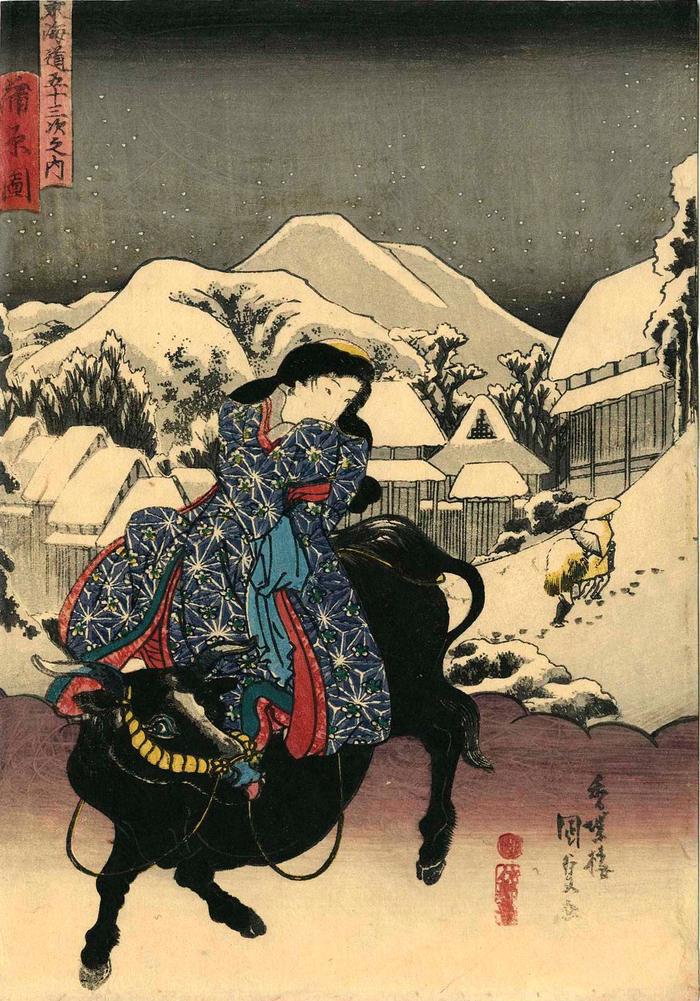Utagawa Kunisada (歌川国貞) / Toyokuni III (三代豊国) (artist 1786 – 01/12/1865)
View of Kanbara (Kanbara no zu: 蒲原図) from the series Fifty-three Stations of the Tōkaidō Road (Tōkaidō gojūsan tsugi no uchi: 東海道五十三次之内)
ca 1838
Signed: Kōchōrō Kunisada (香蝶楼国貞)
Publisher: Sanoya Kihei
Censor's seal: kiwame
Museum of Fine Arts, Boston
National Diet Library
Museum of Fine Arts, Boston - 2nd state of Hiroshige's print
Museum für angewandte Kunst, Vienna
Mt. Fuji and Princess Kagiya Museum
Virginia Museum of Fine Art
Ishikawa Prefectural Museum of Art - they date their copy to 1836
Bryn Mawr
Honolulu Museum of Art
Chazen Museum of Art
Los Angeles County Museum of Art
Berkeley Art Museum and Pacific Film Archive, the University of California
The Library of Congress
Fujisawa Ukiyo-e Museum
Nelson-Atkins Museum of Art
Victoria and Albert Museum All of the prints in this series are chūban sized. The example of this print in the collection of the Museum of Fine Arts in Boston is 9 3/8 × 7 5/16 in. This one in the Lyon Collection is approximately the same size although trimmed slightly at the left side, while the example in Boston is trimmed at the bottom by comparison.
Also, compare the bijin's robe in this example and that in the one in the Los Angeles County Museum of Art. Theirs shows the robe printed only in black on white instead of blue found in the one in the Lyon Collection.
****
This is the sixteenth print in this series. It can also be spelled 'Kambara'.
****
In Tokaido Landscapes: The Path from Hiroshige to Contemporary Artists, 2011, #16, p. 28, speaking of the original Hiroshige print it says in a text by Sasaki Moritoshi: "Hiroshige transformed the warm climate of Kanbara into a snow-covered scene, creating an unforgettable print. Three people walk the road at night. With no conspicuous color in the background, they seem to float dimly in the reflected light of the snow. Their expressions are not visible, adding to the bleakness of the scene. The pair on the right and the person on the left [who is hidden from view in the Kunisada version by the bijin riding on the black ox] have their backs turned to each other; their positions, walking away toward the edge of the frame, tell the tale of the journey - strangers pas one another and continue on their separate ways."
****
According to tradition Princess Jōruri and Yoshitsune fell in love. Eventually he abandoned her, but she followed him as far as Kanbara where she died. The locals honored her and this princess because the origin of jōruri or the puppet theater usually performed to the accompaniment of the shamisen.
****
Illustrated
1) a small black and white reproduction in Hiroshige : an exhibition of selected prints and illustrated books by Sebastian Izzard, 1983, p. 24.
2) in a small color reproduction in Kunisada's Tokaido: Riddles in Japanese Woodblock Prints by Andreas Marks, Hotei Publishing, 2013, page 66, T24-16.
3) in a small black and white reproduction in Kunisada's World by Sebastian Izzard, Japan Society, Inc., 1993, figure 12, page 30. Izzard refers to this print as Kambara zu.
****
In Hokusai and Hiroshige: Great Japanese Prints from the James A. Michener Collection, Honolulu Academy of Arts on page 178 it says: "People in Hiroshige's time as well as later scholars have tried to locate, with no success, the place in Kambara that Hiroshige depicted here. It has also been pointed out that in fact it seldom snows in Kambara."
Sanoya Kihei (佐野屋喜兵衛) (publisher)
landscape prints (fūkeiga 風景画) (genre)
beautiful woman picture (bijin-ga - 美人画) (genre)
